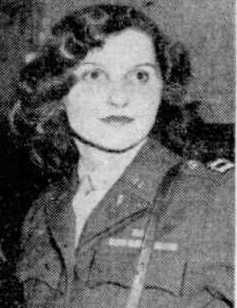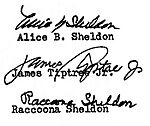James Tiptree Jr. facts for kids
Quick facts for kids
James Tiptree Jr.
|
|
|---|---|

Sheldon in January 1946
|
|
| Born | Alice Hastings Bradley August 24, 1915 Chicago, Illinois, U.S. |
| Died | May 19, 1987 (aged 71) McLean, Virginia, U.S. |
| Pen name |
|
| Occupation |
|
| Education | |
| Period | 1968–1988 (new fiction) |
| Genre | Science fiction |
| Notable awards |
|
| Spouse |
|
| Relatives |
|
| Signature | |
 |
|
Alice Bradley Sheldon (born Alice Hastings Bradley; August 24, 1915 – May 19, 1987) was an American science fiction and fantasy author. She was much better known by her pen name, James Tiptree Jr., which she used from 1967 until her death. For ten years, from 1974 to 1985, she also sometimes wrote as Raccoona Sheldon. It was a big surprise to the public when it was revealed in 1977 that James Tiptree Jr. was a woman. In 2012, Tiptree was honored by being added to the Science Fiction Hall of Fame.
Tiptree's first collection of short stories, Ten Thousand Light-Years from Home, came out in 1973. Her first novel, Up the Walls of the World, was published in 1978. Some of her other famous works include the stories "The Women Men Don't See" (1973), "The Girl Who Was Plugged In" (1974), and "Houston, Houston, Do You Read?" (1976). She also wrote the novel Brightness Falls from the Air (1985) and the short story "Her Smoke Rose Up Forever" (1974).
Contents
Early Life and Adventures
Alice Hastings Bradley grew up in Hyde Park, a university area in Chicago. Her father, Herbert Edwin Bradley, was a lawyer and a naturalist, someone who studies nature. Her mother, Mary Hastings Bradley, wrote many stories and travel books. Alice traveled with her parents from a very young age. In 1921–22, when she was just a child, her family took their first trip to central Africa.
During these trips, Alice was a very well-behaved child. Her mother wrote two non-fiction books for children about their adventures, featuring Alice as the main character. These books were called Alice in Jungleland (1927) and Alice in Elephantland (1929). They included photos of young Alice exploring parts of Africa. The cover of Alice in Jungleland was even designed by Alice herself.

Between her trips to Africa, Alice went to school in Chicago. At age ten, she attended the University of Chicago Laboratory Schools. This was a special school with small classes and a flexible way of teaching. When she was fourteen, she went to a finishing school in Lausanne, Switzerland. Later, she returned to the U.S. to attend a boarding school in Tarrytown, New York.
Adult Life and Early Jobs (1934–1967)
Alice's mother wanted her to have a career, but also hoped she would get married. In 1934, at 19, Alice married William Davey. She left Sarah Lawrence College because married students were not allowed. They moved to Berkeley, California, where she was encouraged to study art. Their marriage ended in 1940.
After her divorce, Alice became a graphic artist and painter. She also worked as an art critic for the Chicago Sun newspaper from 1941 to 1942.
Serving Her Country
Alice joined the Women's Army Auxiliary Corps and became a supply officer. In 1942, she joined the United States Army Air Forces. She worked in a group that analyzed aerial photographs for intelligence. She was promoted to major, which was a high rank for women at that time. She felt very free and independent while in the army.
In 1945, after the war, she married her second husband, Huntington D. Sheldon, known as "Ting." She left the military in 1946. In 1952, she and her husband were invited to work for the CIA, which she accepted. She worked as an intelligence officer but didn't enjoy it much. She left the CIA in 1955 to go back to college.
Becoming a Psychologist
Alice studied at American University from 1957 to 1959. She then earned a doctorate degree in Experimental Psychology from George Washington University in 1967. Her doctoral paper was about how animals react to new things in different places. During this time, she started writing a few science fiction stories. She used the name James Tiptree Jr. to protect her academic reputation.
Her Art Career
Alice started drawing when she was nine years old. She even helped illustrate her mother's book, Alice in Elephantland. Her parents arranged an exhibit of her drawings of Africa at the Chicago Gallery. She sold only one illustration in her life, to The New Yorker magazine in 1931.
In 1936, Alice showed her work in a group art show at the Art Institute of Chicago. She also took private art lessons from a famous artist named John Sloan. In 1939, her self-portrait, Portrait in the Country, was shown at the Corcoran Gallery in Washington D.C. Even with these successes, she stopped painting in 1941. She then found a job as an art critic for the Chicago Sun.
Science Fiction Career (1967–1987)
Alice first discovered science fiction in 1924, when she read Weird Tales magazine. But she didn't start writing it herself until much later. After getting her degrees, she decided to try writing science fiction. She chose the pseudonym (pen name) James Tiptree Jr. in 1967. The name "Tiptree" came from a jar of marmalade. She added "Jr." because her husband suggested it.
She explained that she chose a male name because it felt like good "camouflage." She had often been the first woman in certain jobs and felt a male name would help her stories be judged fairly. She was surprised that her stories were quickly accepted and became popular.
Her first published short story was "Birth of a Salesman" in Analog Science Fact & Fiction in March 1968. She used other pen names too, like "Raccoona Sheldon." When writing as Raccoona, she sometimes struggled to get published until "Tiptree" (her other pen name) helped her.
The Secret Revealed
For ten years, no one knew that James Tiptree Jr. was a woman. People thought the name was used to protect the reputation of someone working in intelligence. Readers and editors usually assumed "Tiptree" was a man. Some people, like writer Robert Silverberg, even said that Tiptree's writing style was "ineluctably masculine" and like Ernest Hemingway's.
"Tiptree" never appeared in public but wrote many letters to fans and other science fiction authors. In these letters, she would present herself as a feminist man. Writing was a way for her to explore themes about escaping a male-dominated society. For example, in her story "Houston, Houston, Do You Read?", astronauts find a future Earth where all men are gone, and the women are doing just fine.
In 1976, "Tiptree" mentioned in a letter that "his" mother, also a writer, had died in Chicago. This detail led curious fans to find the obituary, which mentioned Alice Sheldon. Soon, everyone knew the truth. Alice Sheldon then wrote to her close friend, Ursula K. Le Guin, explaining that she had always told the truth in her letters, except for the signature. She wrote, "The thing is, I am a 61-year-old woman named Alice Sheldon."
After her identity was revealed, some writers were a bit embarrassed. Robert Silverberg added a note to his book introduction, saying he was wrong about Tiptree's gender. Harlan Ellison had also written that "Tiptree is the man" to beat in writing.
After this, Alice Sheldon finished her first full-length novel, Up the Walls of the World. Before that, she was mostly known for her short stories.
Story Themes
A common theme in Alice Sheldon's stories is gender. She was influenced by the rise of second-wave feminism, which focused on women's rights and equality. A great example is her story "The Women Men Don't See" (1973). In this story, like many others, she writes from a convincing male point of view.
Later Life and Legacy
Alice Sheldon continued writing as Tiptree for another ten years. She passed away on May 19, 1987, at her home in Virginia. Her husband also passed away at the same time.
The Otherwise Award
The James Tiptree Jr. Award was created in 1991 by authors Karen Joy Fowler and Pat Murphy. This award celebrates science fiction and fantasy stories that explore or expand our understanding of gender. Many great books have won this award. In 2019, the award's name was changed to the Otherwise Award.
Works by James Tiptree Jr.
Short Story Collections
- Ten Thousand Light-Years from Home (1973)
- Warm Worlds and Otherwise (1975)
- Star Songs of an Old Primate (1978)
- Out of the Everywhere and Other Extraordinary Visions (1981)
- Byte Beautiful: Eight Science Fiction Stories (1985)
- The Starry Rift (1986)
- Tales of the Quintana Roo (1986)
- Crown of Stars (1988)
- Her Smoke Rose Up Forever (1990)
- The Voice That Murmurs in the Darkness (2023)
Novels
- Up the Walls of the World (1978)
- Brightness Falls from the Air (1985)
Other Collections
- Neat Sheets: The Poetry of James Tiptree Jr. (1996)
- Meet Me at Infinity (2000)
Stories Adapted for Other Media
- "The Man Who Walked Home" (1977): adapted into a comic book.
- "Houston, Houston, Do You Read?" (1990): became a radio drama for Sci-Fi Radio.
- "Yanqui Doodle" (1990): also a radio drama for Sci-Fi Radio.
- Weird Romance (1992): an Off-Broadway musical. Part of it is based on "The Girl Who Was Plugged In".
- "The Girl Who Was Plugged In" (1998): turned into a television film for the series Welcome to Paradox.
- The Screwfly Solution (2006): became a television film for the series Masters of Horror.
- Xenophilia (2011): a dance and theater show based on the lives and works of Tiptree and Connie Converse.
Awards and Honors
The Science Fiction Hall of Fame welcomed Tiptree in 2012. She also won many awards for her specific stories and novels:
- Hugo Awards:
- 1974: The Girl Who Was Plugged In (novella)
- 1977: Houston, Houston, Do You Read? (novella)
- Nebula Awards:
- 1973: "Love Is the Plan the Plan Is Death" (short story)
- 1976: Houston, Houston, Do You Read? (novella)
- 1977: "The Screwfly Solution" (novelette, published as by Raccoona Sheldon)
- World Fantasy Award:
- 1987: Tales of the Quintana Roo (collection)
- Locus Award:
- 1984: "Beyond the Dead Reef" (short story)
- 1986: The Only Neat Thing to Do (novella)
- Science Fiction Chronicle Award:
- 1986: The Only Neat Thing to Do (novella)
- Jupiter Award:
- 1977: Houston, Houston, Do You Read? (novella)
Her stories translated into Japanese also won awards:
- Hayakawa's S-F Magazine Reader's Award:
- 1993: "With Delicate Mad Hands"
- 1997: "Come Live with Me"
- Seiun Award:
- 1988: "The Only Neat Thing to Do"
- 2000: "Out of the Everywhere"
- 2008: Brightness Falls from the Air
Images for kids


